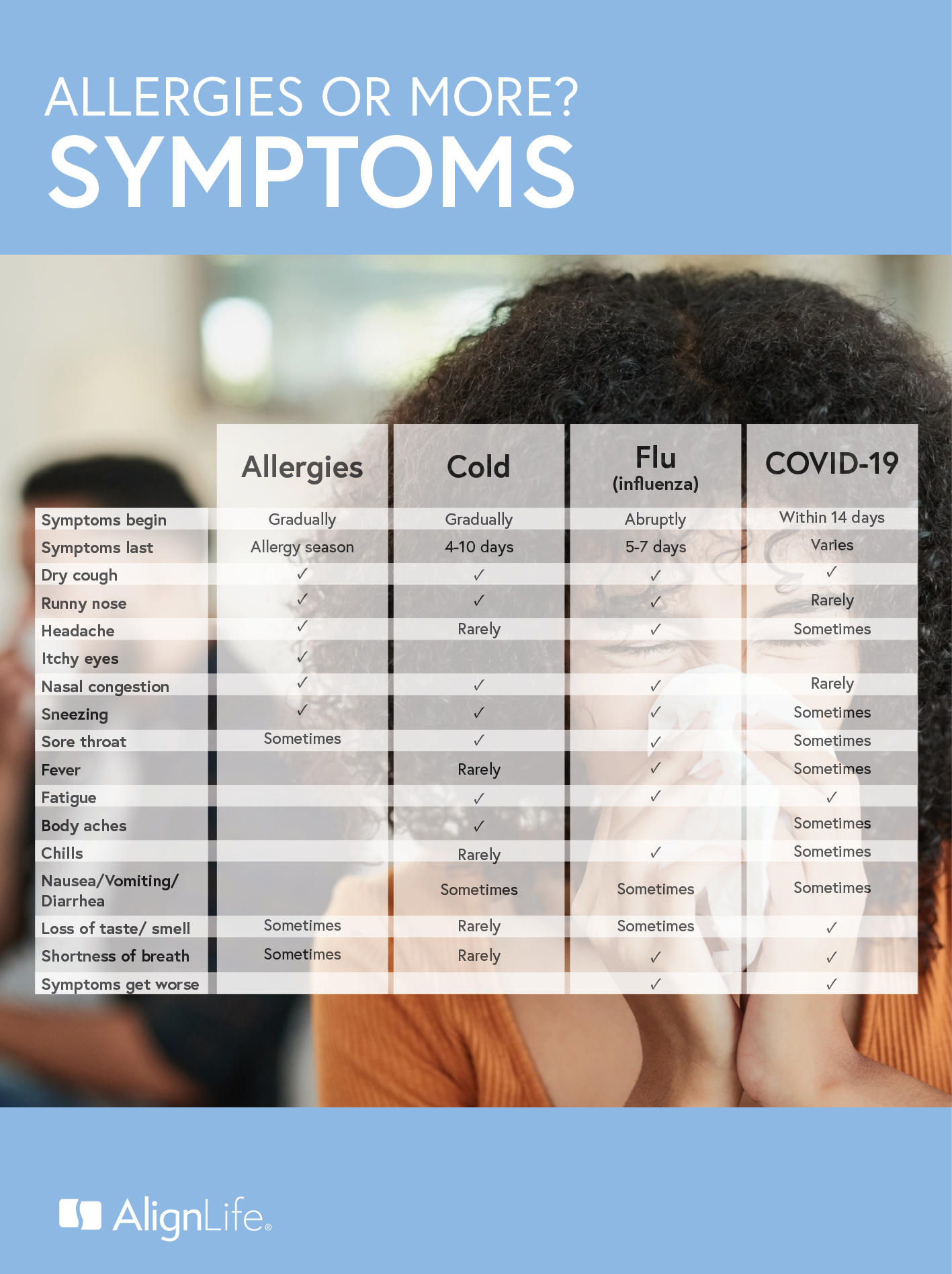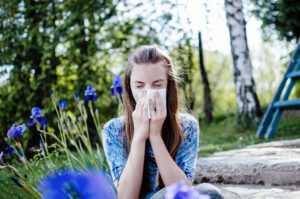In a time where any cough, sneeze or sniffle can bring on looks from those near you, we’re all asking ourselves, “how do I know if this is allergies, a cold, the flu, COVID-19 or something else?” Below we’ll take a quick look at the signs and symptoms of each and give you tips on how you can naturally fight seasonal allergy symptoms before they even start.
The Truth About Seasonal Allergies
Spring and fall are ideal times to be outdoors for many. But it can also present many challenges for those prone to seasonal allergy symptoms. In fact, around 75% of those who are affected by spring allergies also experience allergy-related symptoms in the fall. That means a runny nose, watery eyes, coughing, sneezing, and congestion could or have already started creeping up on you.
Common Causes of Seasonal Allergies
To get a better understanding of what allergies are, let’s look at some of the common culprits behind seasonal allergies:
Outdoor pollens: Grasses, trees and weeds
Pollen is thought to be the primary cause of all seasonal allergies but its source varies depending on the season. In the summer, it’s grasses and weeds such as tumbleweed. In the spring, it’s trees. In the fall, ragweed is the main culprit. Ragweed pollen can travel for hundreds of miles with the wind, making it possible to have allergy symptoms even if there isn’t ragweed in your area.
Molds that thrive indoors and out!
Mold is another common cause of allergies during allergy season. Wet, moist conditions tend to predominate in the fall and spring which creates an ideal environment for mold to grow and thrive. Damp areas in the house such as the basement and bathroom are not the only places where mold can grow. Wet piles of leaves outside can also harbor mold spores and trigger allergy symptoms.
Dust mites in the house
Dust mites are also a concern for seasonal allergy sufferers. As the temperature begins to drop in the late fall season, many individuals begin using their heating units for the first time and this can stir up dust mites in the house.
Typical Seasonal Allergy Symptoms
Allergies are typically defined by:
- runny or stuffy nose
- itchy and watery eyes, mouth and skin
- sneezing
However, there are other illnesses out there that can mimic or take on some of these allergy symptoms. Here’s a quick way to know the difference for each.

Note this list is not be used for medical diagnosis. Some people may not have common symptoms. If you suspect you have more than allergies or a cold, it’s best to touch base with your healthcare provider to find out next steps for treatment and relief and to see if any testing is recommended or required.
- Common Cold Symptoms: Cold symptoms often include sore throat, runny nose, coughing, sneezing, headaches and body aches.
- Common Flu Symptoms: Common symptoms of the flu include fever or feeling feverish/chills (not everyone has a fever with the flu, however), cough, sore throat, runny or stuffy nose, muscle or body aches, headaches, fatigue and possible vomiting and diarrhea (more common in children).
- Common COVID-19 Symptoms: The Centers for Disease Control and Prevention (CDC) lists 11 primary symptoms of COVID-19. They are fever or chills, cough, shortness of breath or difficulty breathing, fatigue, muscle or body aches, headache, sore throat, new loss of taste or smell, congestion or runny nose, nausea or vomiting, and diarrhea.
How to Stop Allergies Before They Start
Check Your Gut Health
A healthy gut is extremely important in your body’s fight against seasonal allergies. It is estimated that around 80% of the immune system is located inside the intestines. Probiotic bacteria in the intestines are responsible for “training” immune cells to react to allergens that enter the digestive tract and blood. If these bacteria are not present in sufficient amounts, your immune system may misfire and trigger an immune response which creates allergy systems.
Eliminate Allergy Triggers
In addition to the natural allergy support formulas mentioned above, you can also take the following precautions in and around your homes:
Pollen Control
- Wear a mask and gloves when working outside in the lawn to help avoid bodily pollen exposure.
- After working outside, take a shower and/or change clothes.
- Minimize having doors and windows open in the home.
- Clean vents and change filters before using the heat for the first time.
Mold Control
- Use fans and try and keep the humidity below 60% in the home.
- Clean up standing water immediately in the basement, bathroom and other areas of the home to help prevent mold growth.
- Get rid of any visible mold by scrubbing it with either detergent or hydrogen peroxide and water. Alternatively, call a mold professional to eradicate severe mold-related issues.
Try Natural Allergy Solutions
Fortunately, there are many ways to help calm allergy symptoms that don’t carry the side effects of common solutions like steroid nasal sprays, over-the-counter antihistamines such as Benadryl, decongestants, and immunotherapy in the form of allergy shots or drops.
Look for these key ingredients in the products you choose:
- Quercetin. This is a natural antihistamine that works by inhibiting immune cells from releasing histamine, a compound responsible for a majority of allergy-related symptoms.
- N-Acetyl Cysteine (NAC). A powerful amino acid-derived compound, this ingredient breaks up mucus so it can drain easier from the sinuses and relieve congestion.
- Eucalyptus Leaf. This herbal ingredient helps break up mucus but can also provide allergy relief by helping it also helps decrease microbial organisms that can fester in the nasal cavities in those suffering from allergies.
- Bromelain. This anti-inflammatory compound relieves allergy symptoms by reducing inflammation, breaking down mucus, and relieving nasal congestion.
Take These Recommended Supplements for Allergy Relief
We recommend trying three great products from Aceva that can help your fight against seasonal allergies. All products contain natural ingredients and have been proven to provide faster, longer-lasting relief. You can also use Aller-Aid and Sine-Aid together for even faster results.
- ALLER-AID is a comprehensive formulation designed to decrease the histamine response during acute allergy symptoms.
- SINE-AID can be used both proactively to help reduce the chances of developing allergy-related symptoms as well as to help provide relief from acute allergy symptoms by working thin mucus and reduce sinus inflammation.
- ULTRABIOTIC can also be used to help improve poor gut health (or leaky gut) that is likely contributing to your overall allergy symptoms. It does so by helping restore the beneficial bacteria in the intestinal tract which are important for healthy immune function and digestion.




